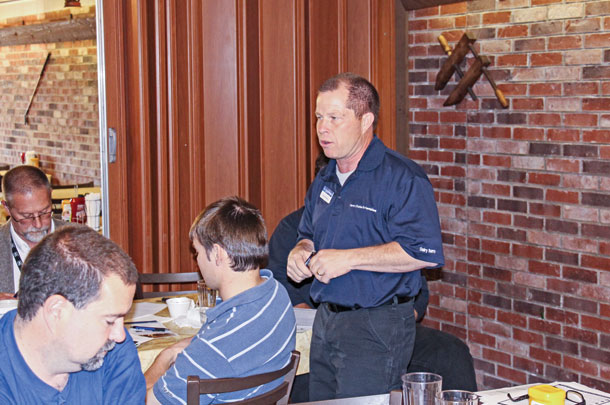Penn State Extension recently did a survey of the projected breakeven cost on 110 Pennsylvania-based dairy farms. The average projected breakeven was $19.04 per hundredweight, about $4 per hundredweight above the April all-milk price of $15 per hundredweight.
What was more telling in the survey, however, was the difference between the highest and lowest breakeven price in the group, with the estimates ranging from $16 to $27 per hundredweight on the 110 farms.
Representatives from Penn State shared this information at four roundtable meetings hosted in May by the Center for Dairy Excellence. The meetings were intended to bring together those individuals serving and supporting Pennsylvania’s dairy farms to discuss the most significant issues influencing today’s dairy marketplace and to share strategies that farms are utilizing to work through the current period of negative profit margins.
The breakeven survey was based on all operating and fixed costs associated with the dairy, so the range was influenced by the amount of principal and interest each farm was responsible for. In other words, higher-leveraged farms had a higher breakeven price.

However, according to Penn State and others in the room, the difference between $16 and $27, in many cases, was in the details of managing all aspects of the herd and the dairy business.
At the end of each meeting, the group shared the strategies they see farms utilizing to navigate their business successfully through the narrow to nonexistent margins that are now widespread across the dairy industry. Here are 10 key strategies shared by the group.
- Watch the little things, and don’t throw the baby out with the bath water. The small investment you make in prioritizing cow comfort can reap big dividends. Paying attention to the little details, like making sure there are plenty of fans and they are all in good working order, is critical to maximizing milk production in the hotter months of the year.
Clean out the waterers regularly, feed during cooler parts of the day, keep the feed pushed up, and don’t overcrowd your herd. Don’t cut back on bedding or on regular herd health measures like footbaths, hoof trimmings and vaccination protocols.
- Develop and follow standard operating procedures. When stress levels are high, corners can get cut. With the current milk price, every penny counts. Maximizing quality premiums and component levels can boost your milk check by more than $1 per hundredweight.
Make sure every employee knows your protocols in place for both milking procedures and feeding strategies. It is easy to drift away from standard procedures when they’re not written down, so write them out and post them in the barn or on the feed wagon for everyone to see and use.
- Manage your forage quality and nutritional strategies. Whether it is haylage, small grain or corn silage, harvesting high-quality feeds is a matter of timing and attention to detail. Make sure you harvest feed when it is at its optimal nutritional quality, that it is packed tightly and stored properly, and fed with minimal amount of shrinkage.
Managing your forage quality and feeding strategies can make a significant impact on both the price of your feed bill and the performance of your herd. Also, watch the additives in your ration. Component values have changed in the past year. Make sure your additives reflect your milk production and component goals based on current market conditions. Challenge your nutritionist to keep feed costs low while maximizing herd health and performance.
- Form partnerships or share equipment with neighboring farms. The cost of equipment can be spread out over additional acres when two or more farms share that cost. Hiring custom operators for planting and harvesting can also cut your equipment costs and enhance your ability to plant and harvest crops in a timely and efficient manner.
Equipment sharing isn’t the only place where farms can partner. Some farms are sharing technology like heat detection software or are sharing specialized employees, like herd managers, calf managers and those who care for sick cows in the herd. If you do share employees, though, it’s important to have biosecurity measures in place to protect against any cross-contamination between herds.
- Manage your youngstock costs. Many farms have gone to group housing of wet calves and feeding acidified milk. Whether you use this approach or other ways to lower your heifer replacement costs, make sure you are thinking through your strategy to get well-grown replacements into the barn as quickly as possible at the lowest cost possible.
- Reproduction is the key to profitability. Keeping calving intervals and the age to first calving within industry-recommended thresholds is critical to maintaining maximum milk production and performance within the herd.
Keeping cows in the herd when they are far-out in lactation can be a profit drainer and can lead to health issues once they finally do freshen in. Make sure you are following protocols for your timed-A.I. strategy closely and keeping reproduction in check.
- Knock out the margin. Raising marginal replacements, keeping marginal cows and farming marginal ground can also quickly drain profits. One nutritionist said that every dairy farm should know that minimal level of production when a cow is providing short-term and long-term value to the herd.
Once she falls below that threshold, it needs to be a quick decision to cull her or, if close to freshening, dry her off. Milking high-SCC cows or treating clinical cases of mastitis multiple times can also be profit draining. Don’t let one cow cost you your quality premium.
- Seek and accept good advice. Several individuals suggested that good farms pay for good consultants, and those struggling often aren’t willing to even accept the free advice out there. Whether you pay for a business consultant or you talk to the people who work with your farm every day, such as your lender, accountant, nutritionist or veterinarian, seek their advice on strategies to move forward. Often, they may bring up an idea that you haven’t considered before.
- Find someone to set your pace. Those producers involved in peer groups say the process of comparing numbers and knowing where they stand against peers motivates them to improve in areas where they are falling behind. If you aren’t in a discussion group, the Dairy Trend Analyzer Program available through our center can help you compare performance against similar farms and historical trends on your own dairy.
- Talk to your lender and know your plan. Lenders said they are hearing from producers who are being very proactive and from those who are really struggling. They are concerned about the middle group that hasn’t reached out yet. Make sure you are communicating with your banker about the strategies you are using to work through the downturn.
Don’t wait until it’s an emergency and you have to call them in last-minute desperation. Call them early and have a plan in place to present.
Managing the margin in times of below-breakeven prices can be tremendously challenging. But dairy managers have learned that tough times do not last. Take advantage of the current situation to focus on the details and assess your management strategies even more closely.
Stronger margins will return. As you position your business to survive this valley, you are also preparing for the next one. PD
PHOTO 1: Cindy Weimer, senior vice president of industry relations at American Dairy Association Northeast, shared an update on the organization and emphasized the importance of dairy producers and those in the industry sharing their story.
PHOTO 2: Craig Williams, Penn State Extension agent, talked about the university’s recent analysis on Pennsylvania dairy farms, which estimated the average breakeven cost in 2016 at $19.10 per hundredweight. Photos courtesy Center for Dairy Excellence.

-
Jayne Sebright
- Executive Director
- Center for Dairy Excellence
- Email Jayne Sebright





